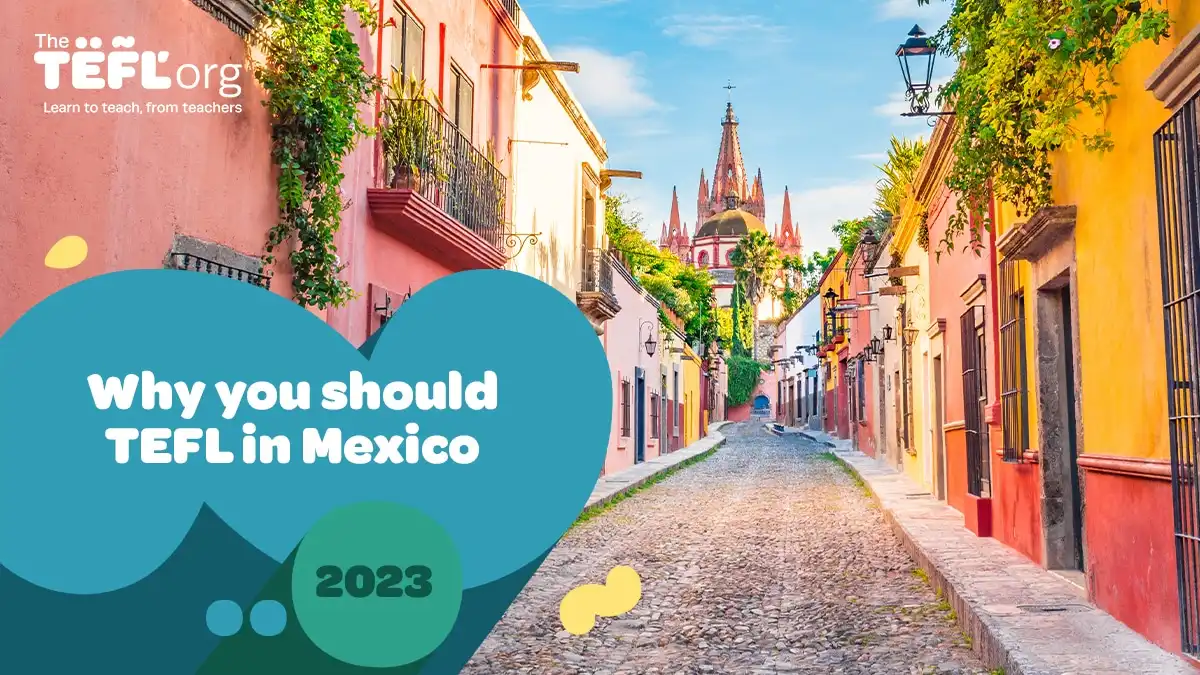- TEFL Courses
- New to TEFL New to TEFL
- Locations
- TEFL Jobs
- Teach Abroad Teach Abroad
- Teach English Abroad
- Teach English in Japan
- Teach English in South Korea
- Teach English in Spain
- Teach English in China
- TEFL Salaries Abroad
- Requirements for teaching abroad
- Teach English abroad without a degree
- How to find teaching jobs abroad without experience
- Can you teach English abroad as a non-native speaker?

- Teach Online
- About Us
- Blog
- Podcast

Why you should TEFL in Mexico in 2024
We’re big fans of Mexico at The TEFL Org. While Latin America doesn’t necessarily rank as highly as nations like Japan, Spain or South Korea on the bucket lists of TEFL teachers, it’s hard to see what wouldn’t be tempting about setting up in Mexico.
A country of immense passion, expression, music and unbelievable food, Mexico is a massively popular tourist destination. However, in terms of TEFL, you’d be surprised to learn that it isn’t necessarily the most popular. That’s confusing to us, because there is so much to enjoy, especially during celebrations like Carnaval, when millions across Mexico line the streets to dance, sing and celebrate.If you think street parades, music, dancing and culture are limited to festivals like Cinco de Mayo and Carnaval, though, you are so gravely mistaken. It’s okay though, we’re here to tell you five reasons you can’t miss out on a TEFL experience in Mexico, and we’re going to take some delightful detours on the way. Everything from Lucha Libre to Peso Pluma - we’ve got it covered, and you’ll see exactly why Mexico has to be considered one of the most exciting countries the world has to offer.
Vamos!

Demand for TEFL teachers
Let’s get the most important part out of the way here: is there a demand for TEFL teachers in Mexico?
Si. Big si . Mexico, despite its proximity to the United States and Canada, has surprisingly low English proficiency. In fact, the country ranks 19th out of 20 Latin American countries, according to EF’s English proficiency index . Staggering, in its own way, given its geography, and the relative English proficiency of the surrounding countries. That’s not something that the Mexican education authorities particularly like, so the jobs across Mexico for TEFL teachers are very much there.
What do you need to teach there? Well, for starters, you don’t need a bachelor’s degree to find work. A high-quality TEFL certification with at least 120 hours of teaching will open the doors across Mexico. You don’t even need teaching experience to get started, either, meaning that if you’re a new TEFL teacher with an unquenchable thirst for adventure, Mexico ought to be your first port of call.
In terms of salaries, TEFL teachers can expect a basic monthly salary (for a full-time role) of around 8,000 – 20,000 pesos (£300 – £730/ $400 – $1,000) per month - but it varies from state to state and city to city. It might not sound like megabucks, but the cost of living in Mexico is comparatively cheap, even for inner-city accommodation.
From kindergartens to universities, to international, private and public schools, TEFL teachers are needed from coast to coast. If you have some advanced TEFL training, specifically in Business English , then you’ll find it even easier to find work.
While the requirements for TEFL teachers are lenient, having a degree and experience will always help land better-paid jobs. If you’re just getting started with your TEFL career though, Mexico is a great place to begin.
Festivals: from Cinco de Mayo to Carnaval and beyond
Perhaps the most famous Mexican festival worldwide is Cinco de Mayo. In Puebla, Cinco de Mayo is a major deal: we’re talking military parades, a carnival atmosphere and celebrations of real historic value . It’s the celebration of a famous military win over France in 1862, and it’s important to shatter a couple of myths here: it’s not the date of Mexican independence, and it’s also not a traditionally Mexico-wide celebration. When it’s the start of May, Puebla is where the party is.
While Cinco De Mayo is normally reserved for Puebla, Carnaval is very much a nationwide affair. Taking place over three days, preceding Ash Wednesday and the start of Lent (Mexico’s principal religion is Catholicism), Carnaval is a buoyant, colourful and proud celebration of all things Mexican.
The exact type of Carnaval experience you have is going to vary by city. For example, Shrove Tuesday in Tepozltán and Huejotzingo features chinelos - masked dancers - who roam the streets. In other cities, like Veracruz and Cozumel, Carnaval is more akin to Mardi Gras in New Orleans; streets lined with revellers, drink flowing, local music blaring and a party that doesn’t stop.
Expect fireworks, incredible street food, stalls, the finest tequila and watching the sunset on gorgeous beaches. Across Mexico, hotels and transportation can be booked up even 6 months in advance; Carnaval is a very big deal indeed.
Not done celebrating yet? Try Diez y Seis, Mexico’s celebration of Independence, or Dia de la Raza , a rejection of Columbus Day and, instead, a day marked to emphasise the uniqueness and history of indigenous peoples in Mexico. You’ll also no doubt know Dias de los Muertos (Day of the Dead), in which, rather than mourning, the spirits of departed loved ones are celebrated with food, drink and celebration. This is a festival that links back to Aztec ideas of the after-life and loss.

Dancing, music and celebration
If you aren’t able to get your fill of dancing, music and festival atmospheres from Carnaval, don’t despair: there’s plenty more where that came from.
Mexican pop acts - and indeed, Latin American more generally - are everywhere. While Puerto Rico has established mega-stars like Bad Bunny and Daddy Yankee, Mexico more than holds its own. The Mexican billboard chart is a great place for any newbie to dive into what’s big, with names like Peso Pluma and La Kelly sure to reach worldwide audiences before long.
If Reggaeton and hip-hop aren’t quite your thing, North Mexico’s modern psych scene has been bubbling away for years, and Mexican jazz continues to be underrated - somewhat mystifyingly - outside El Tri.
If you’re looking for a distilled experience of traditional Mexican music within one event, you’re in luck - Oaxaca’s Guelaguetza Dance Festival is one of the most popular events in Mexico. The festival, held in late July, is a celebration of villagers from across Oaxaca coming together to celebrate their heritage, through music, dancing and increasingly elaborate costumes.
If you’re into music and dancing, you’ll love Mexico. It’s just that simple.
Lucha Libre
Not everyone will admit they’re into wrestling. “It’s fake!” some say. “It’s scripted!”. Whatever - Mexican wrestling is something entirely different, known as Lucha Libre, and it is a gigantic deal.
If you’re looking for an evening’s entertainment, you could do far, far worse. If the sight of men and women leaping around acrobatically, using their acting skills to drive stories and, perhaps most pertinently, fighting for a passionate crowd sounds like the kind of thing you’d enjoy, Mexico does it like no other.
There are two types of wrestling in Mexico. First,
there’s the mainstream type
, a la WWE (or WWF if you’re of a certain vintage). Think big productions, with entrance music, storylines and high stakes - as well as high flying. The costumes, as you’d expect, prominently feature classic Lucha Libre masks, and the identity of the wrestlers being kept hidden is a sacred part of the process.
If you want a grimier, arguably more “authentic” experience, Mexican Street Wrestling is where it’s at. While there’s still an emphasis on athleticism, the street variant of wrestling is a little rougher around the edges, with weapons and feats of daredevil courage that need to be seen to be believed.
Even wrestling cynics will surely be able to enjoy the show; anyone can appreciate high-flying, acrobatic displays, and you don’t necessarily need fluency in Spanish to get a gist of who’s feuding with who.
Sport
Don’t think the authentic Mexican experience can be reduced to five sections, because it can’t. The food is unbelievable, the Mayan and Aztec history, the views, everything - Mexico is a unique and stunning place to live and work.
That said, if you want to really pinpoint where Mexican passion can be found, it’s in sport. Football (Soccer) is enormous, and extremely well-attended. The women’s game in Mexico has set worldwide records for attendance, despite a professional league only being formed for the 2017-18 season. In men’s football, the top professional league is Liga MX, which has some of the biggest clubs on the global west - we’re talking Club America (Mexico’s most successful club side), Tigres, Atlas, Pumas, Cruz Azul, Santos Laguna and so many more household names.
If you want to dive in at the deep end and experience the best atmospheres that Mexican football has to offer, you can’t do better than El Súper Clasico . A battle between Guadalajara and Club America, the Súper Clasico makes Liverpool v Manchester United feel like an afternoon antiquing by comparison. If you’re in Nuevo Leon, you can’t miss the Clásico Regiomontano, a rivalry that’s spanned 128 matches (at the time of writing) between Monterrey and Tigres, two fierce opponents who regularly feature near the top of the league.
Alongside football, Mexico has produced more baseball talents than we could hope to mention here. Again, it’s exceedingly well-attended, with big clubs including Diablos Rojos del México, Tigres de Quintana Roo and Sultanes de Monterrey.Basketball, bull riding and American football are also popular in Mexico, so you’ll not be short for entertainment if you’re the sporty kind!
Are you interested in finding out more about teaching English in Mexico?
Check out our Mexico country guide here!













Leave a Comment
Your email address will not be published.
(0/1500 characters)
Quick Maths Test